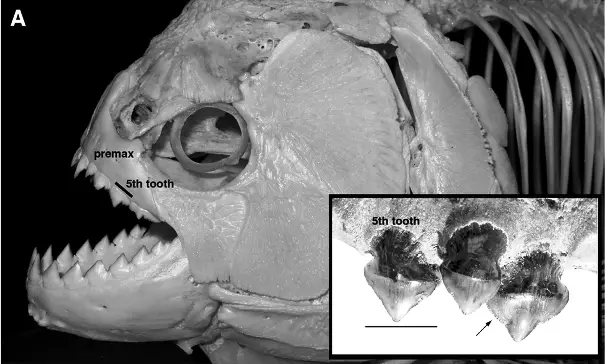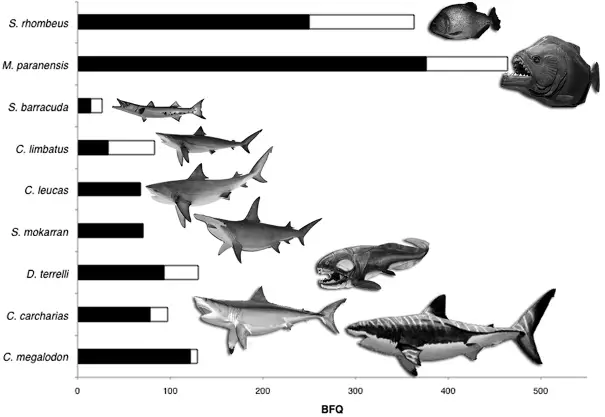Megapiranha had record-breaking bite

Skull anatomy of S. rhombeus (photo by SH) and fossil teeth of M. paranensis (inset). © Cione et al.
New research published in the journal ‘Scientific Reports’ demonstrates the extraordinary bite force of modern day piranhas plus the extinct giant Miocene piranha, Megapiranha paranensis.
Pirhanas are included in the family Serrasalmidae which has three main evolutionary lineages, the carnivorous piranha-clade, the omnivorous Myleus-clade, and the herbivorous pacu-clade. Their teeth and dentition demonstrate a strong functional adaptation to diet, and these features have been used to classify them for decades.
For example, the carnivorous species typically have jaws lined with a single row of 6–7 serrated, multi-cusped, triangular, blade-like teeth, while those of herbivorous species tend to be flattened and molar-like.

The bite force of the black piranha, Serrasalmus rhombeus was used to predict that of Megapiranha. © Adam Carvalho
In 2009, Cione et al. described an extinct, giant serrasalmid species from a single fossilized premaxilla jaw bone fragment that had a set of three triangular teeth set in a zig-zag pattern.
Megapiranha paranensis inhabited the Paraná geological formation in Argentina around the time of the Miocene and its teeth have compressed pointed cusps with finely serrated cutting edges similar to those of a shark, but with a robust, broad base.
These morphological similarities with modern-day serrasalmids place M. paranensis as sister to the carnivorous piranha-clade but slightly intermediate with the herbivorous ‘pacu-clade’ of the Upper Miocene, and its teeth were seemingly equipped both to cut soft flesh and crush harder prey items.
By recording the bite forces of the black piranha, Serrasalmus rhombeus, the largest modern-day serrasalmid, Justin Grubich and his team from the American University in Cairo were able to hypothesise the feeding ecology of M. paranensis, reconstruct its bite forces and investigate what its unique dentition might have been used for.
They concluded that for its relatively small size, Megapiranha paranensis‘ bite dwarfed that of other extinct mega-predators, including the infamous whale-eating shark Carcharodon megalodon and enormous Devonian placoderm, Dunkleosteus terrelli.
Their results show that S. rhombeus can produce an in-vivo bite force of 320 N, the strongest yet recorded for any bony or cartilaginous fish to date in relation to its size. In fact, this is a bite force in excess of 30 times its weight, and more than three times stronger than that of an equivalent-sized American alligator.
This is achieved via over-sized adductor muscles in the mandible which in S. rhombeus‘ comprise more than 2% of its total body mass, another record among bony fishes, which function alongside a highly-modified jaw-closing lever.
S. rhombeus can grow to a length of 40-45 cm but Megapiranha measured at least 71.5 cm, and the scientists’ analysis predicted that its bite was equivalent to the anterior bite force of a great white shark weighing over 400 kg!
Its diet remains unclear, but the shape and morphology of its teeth makes them potentially-suited to deal with both soft and hard prey items, raising the question of whether they evolved in order to not only slice through flesh but also crush bone.
Hypothetically, it may therefore have preyed on turtles, armoured catfishes and, to a lesser extent, the limbs of larger terrestrial mammals.
For further information refer to the full, open access paper: Grubich, J. R., S. Huskey, S. Crofts, G. Orti and J. Porto. 2012. Mega-Bites: Extreme jaw forces of living and extinct piranhas (Serrasalmidae). Scientific Reports 2: article 1009
Category: Blogs, Discoveries | Comment »




Product reviewers wanted
Are you still looking for product reviewers?
19th Dec 2024
Product reviewers wanted
Hey! Interesting article!
17th Dec 2024
Site improvements
Got it! Thanks for the update. It's good to know that Seriously Fish is working on improving the site's performance and addressing the email and forum...
21st Nov 2024
Responsive design
Nice
13th Nov 2024
Responsive design
it is a complete malfunctioning horror on iphone and ipad.
10th Nov 2024